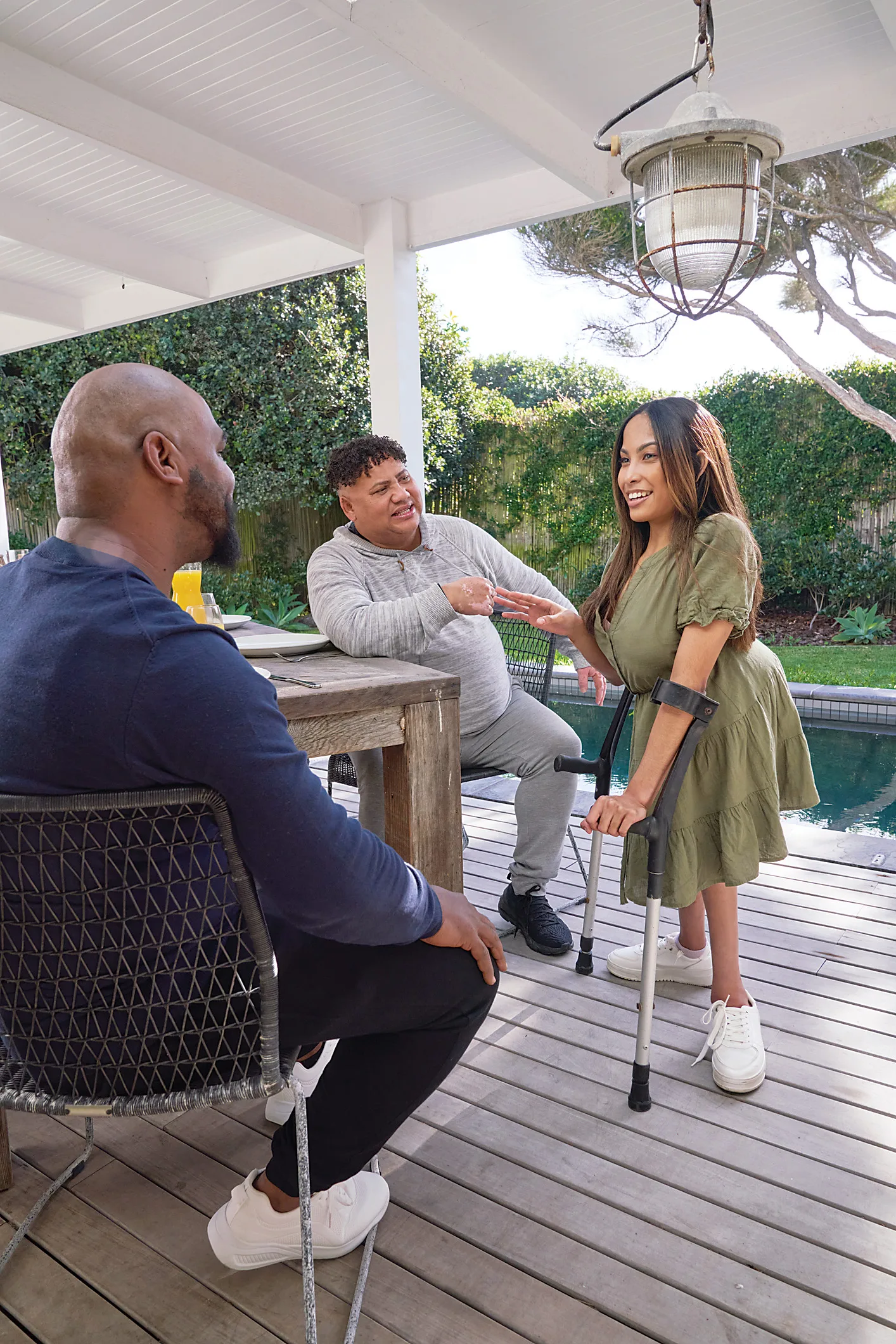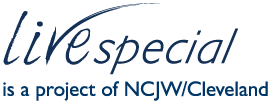
By: Erin Sernoffsky
All people have a right to accessible public spaces, services, transportation and communication, regardless of ability.
Since a disability is not always visible, roadblocks to accessibility are not necessarily obvious to people who do not have this lived experience, and solutions often are not immediate. While it can be tempting to simply avoid these circumstances altogether, with knowledge, practice and a strong community, advocating for your needs or your family member can become empowering.
“Self-advocacy can be difficult for many reasons, especially for individuals with disabilities who may need support to get started,” says Theresa Maier, of Copley, who understands this difficulty both personally and professionally.
Maier serves as a support specialist for the Autism Society of Greater Akron (ASGA) and is the mother to an 8-year-old boy with autism. “Some people don’t know where to begin, worry about upsetting others, struggle to communicate their needs, or feel like they won’t be taken seriously,” she says. “But as you gain confidence and practice, it becomes easier.”
Understanding your rights that are protected under law, knowing your specific needs and how to effectively communicate them, and identifying resources and allies in the broader community are all essential to successfully advocate for yourself.
Understanding
Your Rights
First and foremost, you must understand your rights under federal and local laws. Remember, access is not a gift — it’s a right.
While state and local laws vary, the Americans with Disabilities Act (ADA) is the key to understanding what rights are guaranteed everywhere. While this sweeping legislation covers many areas, in simple terms it protects from discrimination, guarantees equal opportunities in employment, and ensures access to public accommodations, transportation, telecommunication, government services, and businesses and spaces open to the public.
Disability presents in so many ways, not all of them visible, and accommodations made under the ADA range from the obvious — ramps and wheelchair accessible restrooms in public buildings — to the less immediately apparent, such as intuitive hardware fixtures like levers on doors.
The word “discrimination” carries heavy weight, however, roadblocks to equal opportunity qualify as discrimination. While it’s hard to understand if what you’re experiencing qualifies as discrimination, there are many tools that can serve as a guide to understand the ADA. The Civil Rights Division of the Department of Justice offers many online tools to better understand your rights, including their Disability Rights Guide (ada.gov/resources/disability-rights-guide/).
Discrimination can take on many forms; some examples include: a business owner not allowing a service dog to enter a public space; new buildings that fail to take into account mobility or sensory impairments; a concert or sporting venue that does not provide accessible seating; a ramp into a building that is too steep; and a restaurant that does not ensure pathways between tables are adequately wide.
Understanding
Your Needs
Circumstances change. Needs shift. Wishes alter. However, knowing what your needs are in a given situation, effectively communicating your wishes, and understanding potential barriers are all critical in speaking up on behalf of yourself or a loved one.
For example, Maier knows that waiting, crowds or loud noises can be especially challenging for her son.
“I always make sure we have snacks and some type of entertainment packed, whether it’s a tablet, book or game,” she says. “Places that can be particularly challenging are doctor’s office lobbies, and places that are crowded. We try to plan our trips to crowded places early to beat the rush, and also seek out places that offer sensory-friendly hours.”
Clearly identifying needs and wishes in advance is important and has found tools to help.
“A great way for individuals with disabilities to start advocating for themselves is by using Charting the LifeCourse tools (lifecoursetoolscom), which help individuals determine what’s important to them, what goals they have, and what support they need,” Maier says. “These tools make it easier to speak up, make decisions, and create a future plan so others can understand how to best support you.
“A popular tool is the LifeCourse One-Page Description, which lets individuals share important information about themselves, like what people like about them, what’s important to them, and how others can best support them,” she adds. “It can be used in many settings, such as at the start of a new school year, at the doctor’s office, or in meetings, to help others quickly understand your needs. This tool makes self-advocacy easier by having everything mapped out and in one place.”
Briana Seth is a specialist for Opportunities for Ohioans with Disabilities’ Accessible Ohio program, which works with organizations, at no cost, to support their goals to be more accessible. One of her team’s initiatives is helping businesses create Accessibility Statements and webpages, which serve as a guide to clearly communicate accessibility features so individuals can see what’s available in advance of their trip.
“A museum may include information on a sensory space on their accessibility webpage. A guest may visit this page before their visit, and know this feature is available,” she says. “Another example is the Accessibility Map resource that describes how this can be a helpful tool for people to use to plan and enjoy their visit, navigate the environment, and find the accessibility features at the organization. For example, an amusement park may include its universal changing table on the park’s map, which helps a parent locate this feature when visiting the park.”
Understanding Your Village
You are not alone, and the responsibility of creating an accessible community is shared by all. Business owners, policy makers and service providers all have a responsibility to be proactive in identifying and eliminating barriers. However, many don’t know where to begin, or believe accommodations will be too costly, which makes the work of Seth and her fellow Accessible Ohio Specialists all the more important. They provide no-cost consultations with Ohio organizations to help them optimize their accessibility.
“There are aspects to consider when creating welcoming and accessible spaces,” says Seth. “These include how guests are planning their visit, how they will arrive and navigate the space, how they will experience the space, and how they will manage their personal care needs.”
The Accessible Ohio program helps organizations take responsibility and implement better policies, design elements and more through in-person and virtual consultation, online tools, best practices, advice on grant and funding requests, and much more.
“Each organization is unique in their awareness of accessibility features and the extent to which they have made their environment accessible,” she says. “We meet organizations where they are on their accessibility journey. To assist organizations with selecting and implementing goals, the Accessible Ohio team has created the Priority Tool and Game Plan [which] can be used by the organization to gain awareness of accessibility features, develop and prioritize goals, and create a plan to achieve them.”
Other resources include Disability Rights Ohio, which provides legal assistance for individuals with disabilities; the Ohio Disability Advocacy Alliance, which is a group of volunteer advocates for employment and housing issues; and the Ohio Self Determination Association, which provides training, support and networking for people with disabilities as well as policymakers.
“ASGA strives to empower individuals with autism and their families to make informed decisions in the planning and delivery of individualized, evidence-based services and support,” Maier says. “Each individual and family has the right to choose the services that best meet their individual needs.”
Maier and her colleagues at ASGA provide services in five key areas: education, adapted community events, social support, referrals and information, all with the goal of empowering individuals to make the choice that’s right for them. There are many other groups working to improve the lives and agency of people with disabilities, such as United Cerebral Palsy of Greater Cleveland, the American Council of the Blind of Ohio, the Amputee Coalition, and many more.
Family members and friends can also play a pivotal role in supporting their loved ones.
Seth points to tools such as Accessible Ohio’s resource page on its website for excellent information for friends and families. “This page includes tools and guides on a variety of accessibility and inclusion topics, organized by the four priority areas of Planning and Awareness, Navigation, Experience and Personal Care. These resources can be useful for everyone to plan their visit to a venue or attraction,” she says.
Advocacy is intimidating, but clearly understanding your rights, knowing what you want, and identifying your people can help you speak up with confidence and influence real change.
What Does Access Look Like?
The Americans with Disabilities Act provides protection against discrimination and ensures equal access to opportunities in the areas of employment, housing, government services, public transit, businesses that are open to the public, and telecommunications.
While no two people are alike and no circumstances are the same, examples of compliance under the ADA are:
Employment:
Flexible work schedules, provide adaptive tools to successfully complete tasks, provide assistive technology.
Housing:
Allow service animals in buildings that do not otherwise allow pets, dedicated parking spaces for individuals with disabilities.
Transportation:
Assistance in boarding and disembarking aircrafts, accessible vehicles and stations, audio cues for upcoming stops.
Government Services:
Accessible polling places and voting booths, audio enhancement or ASL translation services.
Public Spaces:
Flexible seating, provide assistive audio devices, adaptive door handles or switches, charging stations for power mobility devices, accessible entrances and restrooms.
Sensory Sensitivity:
Provide noise cancelling headphones, create calming sensory-friendly spaces, establish specific sensory-friendly hours which reduce or eliminate loud noises or flashing lights.
Advocacy and Rights Resources to Consider
- Accessible Ohio, ood.ohio.gov/accessible-ohio
- Amputee Coalition, amputee-coalition.org
- The ARC of Ohio, thearcofohio.org
- Brain Injury Association of Ohio, biaoh.org
- Disability Rights Ohio, disabilityrightsohio.org
- Great Lakes ADA Center, adagreatlakes.org
- Ohio Association on Aging, ohioaging.org
- Ohio Developmental Disabilities Council, ddc.ohio.gov
- Ohio Self Determination Association, osdaohio.org
- Opportunities for Ohioans with Disabilities, ood.ohio.gov
- United Cerebral Palsy of Greater Cleveland, ucpcleveland.org

